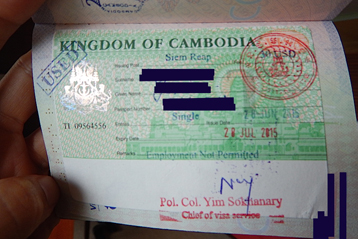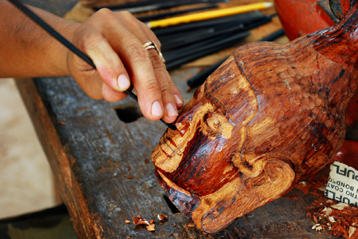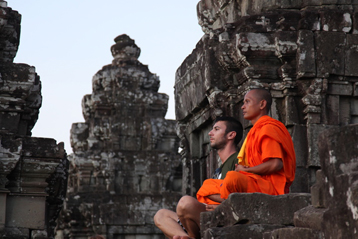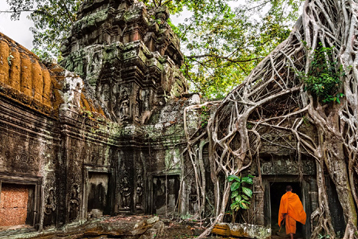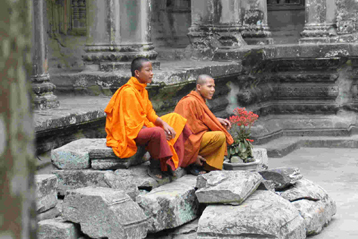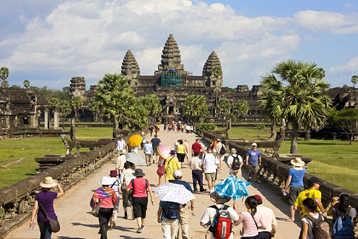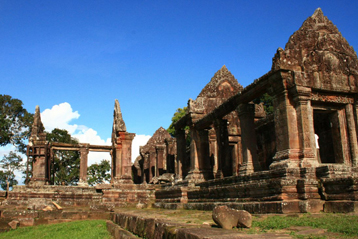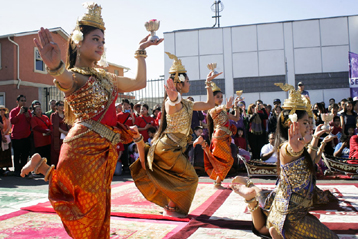Sights in Phnom Penh
Phnom Penh is a small city and most of the major sights are fairly central. The most important cultural sights can be visited on foot and are located near the riverfront in the most beautiful part of the city.Phnom Penh is a small city and most of the major sights are fairly central. The most important cultural sights can be visited on foot and are located near the riverfront in the most beautiful part of the city.
The Royal Palace is a striking structure near the riverfront, bearing a remarkable likeness to its counter part in Bangkok. It stands on the site of the former citadel, Banteay Kev, and looks out on to Samdech Sothearos Blvd between Ph 184 and Ph 240. Visitors are only allowed to visit the palace’s Silver Pagoda and its surrounding compound. It is an extra US$2 to take in a camera and US$5 for a video camera. However, photography is not permitted inside the pagoda itself.
Silver Pagoda
The Silver Pagoda, so named because the floor is covered with over 5000 silver tiles weighing 1kg each, is also known as Wat Preah Keo (Pagoda of the Emerald Buddha). It was constructed of wood in 1892 during the rule of King Norodom, who was apparently inspired by Bangkok’s Wat Phra Keo, and was rebuilt in 1962.
The Silver Pagoda was preserved by the Khmer Rouge to demonstrate to the out- side world, its concern for the conservation of Cambodia’s cultural riches. Although some 60% of the pagoda’s contents were destroyed under Pol Pot, what remains is spectacular. This is one of the few places in Cambodia where objects embodying some of the brilliance and richness of Khmer civilization can still be seen.
National Museum
Admission US$3 – Open 8am-5pm
The National Museum of Cambodia is home to the world’s finest collection of Khmer sculpture. Located just north of the Royal Palace, the museum is housed in a graceful terracotta structure of traditional design (built 1917-20), with a lush courtyard garden providing the perfect backdrop to an out- standing array of delicate objects.
The museum comprises four courtyards, facing a garden. The most significant displays of sculpture are in the courtyards to the left and straight ahead of the entrance. Some highlights include the eight-armed statue of Vishnu from the 6th or 7th century AD, the statue of Shiva and the sublime statue of Jayavarman VII seated, his head bowed slightly in a meditative pose. The museum also contains displays of pottery and bronzes dating from the pre-Angkorian periods of Funan and Chenia (4th to 9th centuries), the Indravarman period (9th and 10th centuries), the classical Angkorian period (10th to 14th centuries), as well as more recent works. There is a permanent collection of post-Angkorian Buddha, many of which were rescued from Angkor Wat when the civil war erupted.
Unfortunately, photography is prohibited inside the museum. English- and French- speaking guides (from US$2, depending on group size) are available, and there is also a useful exhibition booklet, The New Guide to the National Museum, available at the front desk.
The Royal University of Fine Arts has its headquarters in a structure behind the main National Museum building.
Wat Phnom
Admission US$1
Set on top of a 27m-bigh tree-covered knoll, Wat Phnom is on the only hill in town. According to legend, the first pagoda on this site was erected in 1373 to house four statues of Buddha deposited here by the waters of the Mekong River and discovered by a woman named Penh. The main entrance to Wat Phnom is via the grand eastern staircase, which is guarded by lions and naga (mythical serpent) balustrades.
Today, many people come here to pray for good luck and success in school exams or business affairs. When a petitioner’s wish is granted, he or she returns to make the offering promised – such as a garland of jasmine towers or a-bunch of bananas, of which the spirits are said to be especially fond – when the request was made.
Wat Phnom Wall
The vihara (temple sanctuary) was rebuilt in 1434, 1806, 1894 and 1926. West of the vihara is a huge stupa containing the ashes of King Ponhea Yat. In a pavilion on the southern side of the passage between the vihara and the stupa is a statue of a smiling and rather plump Madame Penh.
A bit to the north of and below the vihara is an eclectic shrine dedicated to the genie Preah Chau, who is especially revered by the Vietnamese. On either side of the entrance to the chamber containing a statue of Preah Chau are guardian spirits bearing iron bats. On the tiled table in front of the two guardian spirits are drawings of Confucius, as well as two Chinese-style figures of the sages Thang Cheng (on the right) and Thang Thay (on the left). To the left of the central altar is an eight-armed statue of Vishnu.
Down the hill from the shrine is a royal stupa sprouting full-sized trees from its roof. For now, the roots are holding the bricks together in their net-like grip, but when the trees die the tower will slowly crumble. If you can’t make it out to Angkor, this stupa will give you a pretty good idea of what the jungle can do (and is doing) to Cambodia’s monuments.
Wat Phnom can be a bit of a circus. Beggars, street urchins, women selling drinking and children selling birds in cages (you pay to set the bird free – locals claim the birds are trained to return to their cage after- wards) pester everyone who turns up to climb the 27m to the summit. Fortunately it’s all high-spirited stuff, and it’s difficult to be annoyed by the vendors, who, after all, are only trying to eke out a living. You can also have a short elephant ride around the base of the hill, perfect for those elephant – trekking photos, but without the accompanying sore butt.
It is hardly the most stunning location you are likely to visit m Cambodia, but as a symbol of Phnom Penh, it is a popular spot.
Independence Monument
Add: Corner Norodom & Sihanouk Blvds
The Independence Monument is modeled on the central tower of Angkor Wat and was built in 1958 to commemorate the country’s independence from France in 1953. It also serves as a memorial to Cambodia’s war dead (at least those that the current government chooses to remember) and is sometimes referred to as the Victory Monument. Wreaths are laid there on national holidays. Nearby, beside Samdech Sothearos Blvd, is the optimistically named Cambodia-Vietnam Friendship Monument, built to a Vietnamese (and very communist) design in 1979.
More guide...
Responsible Travel
Being a responsible eco tour operator is at the heart of what ACTIVETRAVEL ASIA is all about. From the start, we have been committed to offering low-impact tours that benefit traveler and host alike. We work with local communities, businesses and individuals to develop sustainable tourism opportunities that help local economies while minimizing negative environmental and cultural impacts.
Asia Travel News


